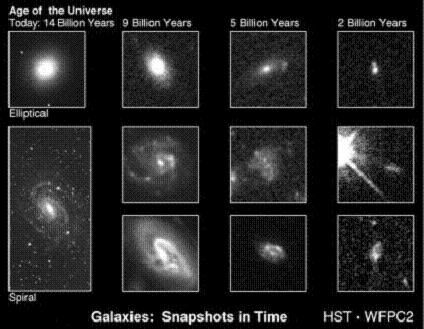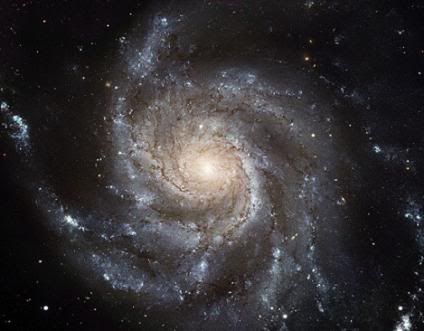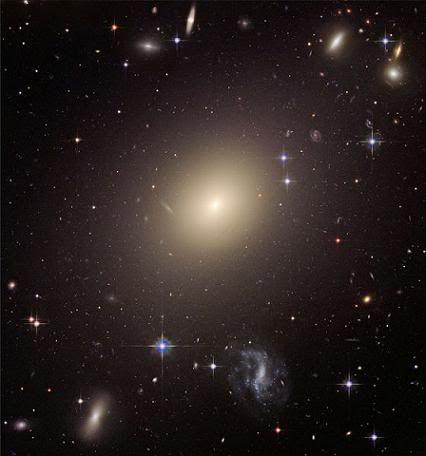Post by glactus on Jan 16, 2010 5:26:11 GMT
For the first time, two astronomers have explained the diversity of galaxy shapes seen in the universe. The scientists, Dr. Andrew Benson of the California Institute of Technology (Caltech) and Dr. Nick Devereux of Embry-Riddle University in Arizona, tracked the evolution of galaxies over thirteen billion years from the early Universe to the present day. Their results appear in the journal Monthly Notices of the Royal Astronomical Society.

Galaxies snapshot in time
galaxies are the collections of stars, planets, gas and dust that make up most of the visible component of the cosmos. The smallest have a few million and the largest as many as a trillion stars. American astronomer Edwin Hubble first developed a taxonomy for galaxies in the 1930s that has since become known as the 'Hubble Sequence'.
There are three basic shapes: spiral, where arms of material wind out in a disk from a small central bulge, barred spirals, where the arms wind out in a disk from a larger bar of material and elliptical, where the galaxy's stars are distributed more evenly in a bulge without arms or disk. For comparison, the galaxy we live in, the Milky Way, has between two and four hundred thousand million stars and is classified as a barred spiral.

M 101 The pinwheel spiral galaxy in Ursa major
Explaining the Hubble Sequence is complex. The different types clearly result from different evolutionary paths but until now a detailed explanation has eluded scientists.

The beautiful barred spiral NGC 1300 in Eridanus
Benson and Devereux combined data from the infrared Two Micron All Sky Survey (2MASS) with their sophisticated GALFORM computer model to reproduce the evolutionary history of the Universe over thirteen billion years. To their surprise, their computations reproduced not only the different galaxy shapes but also their relative numbers.

The giant elliptical galaxy Eso 325-G004 near Centaurus
Our Milky Way galaxy's barred spiral shape suggests it has seen a complex evolutionary history, with only a few minor collisions and at least one episode where the inner disk collapsed to form the large central bar.
These new findings set a clear direction for future research. Our goal now is to compare the model predictions with observations of more distant galaxies seen in images obtained with the Hubble and those of the soon to be launched James Webb Space Telescope.

Credits:
Images: Wikipedia.
text:
The Caliornian institute of technology - Andrew Benson.
Embry-Riddle University of Arazona - Dr.Nick Devereax.
See more at Space daily.com
http://www.

Galaxies snapshot in time
galaxies are the collections of stars, planets, gas and dust that make up most of the visible component of the cosmos. The smallest have a few million and the largest as many as a trillion stars. American astronomer Edwin Hubble first developed a taxonomy for galaxies in the 1930s that has since become known as the 'Hubble Sequence'.
There are three basic shapes: spiral, where arms of material wind out in a disk from a small central bulge, barred spirals, where the arms wind out in a disk from a larger bar of material and elliptical, where the galaxy's stars are distributed more evenly in a bulge without arms or disk. For comparison, the galaxy we live in, the Milky Way, has between two and four hundred thousand million stars and is classified as a barred spiral.

M 101 The pinwheel spiral galaxy in Ursa major
Explaining the Hubble Sequence is complex. The different types clearly result from different evolutionary paths but until now a detailed explanation has eluded scientists.

The beautiful barred spiral NGC 1300 in Eridanus
Benson and Devereux combined data from the infrared Two Micron All Sky Survey (2MASS) with their sophisticated GALFORM computer model to reproduce the evolutionary history of the Universe over thirteen billion years. To their surprise, their computations reproduced not only the different galaxy shapes but also their relative numbers.

The giant elliptical galaxy Eso 325-G004 near Centaurus
Our Milky Way galaxy's barred spiral shape suggests it has seen a complex evolutionary history, with only a few minor collisions and at least one episode where the inner disk collapsed to form the large central bar.
These new findings set a clear direction for future research. Our goal now is to compare the model predictions with observations of more distant galaxies seen in images obtained with the Hubble and those of the soon to be launched James Webb Space Telescope.
Credits:
Images: Wikipedia.
text:
The Caliornian institute of technology - Andrew Benson.
Embry-Riddle University of Arazona - Dr.Nick Devereax.
See more at Space daily.com
http://www.


